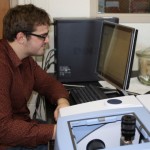January term is a time for experiential learning on this campus, and for some students and faculty, that means it’s a great time for research, scholarship, and creative work. One day near the end of J-term, I took a walk around Nobel Hall and visited some research-based courses and some students doing independent studies. I’ll apologize up-front for the terrible formatting– I’ve been fighting with WordPress for weeks and cannot figure out how to make it look any nicer!
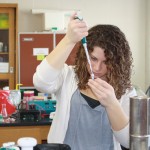
Kendra Braelgelman purifies DNA that she amplified by PCR and then digested with restriction enzymes, preparing the DNA to be inserted into a vector. (Dr. Marz's class)
First, I stopped by Dr. Karla Marz’s and Dr. Kimberly Murphy’s (both biology faculty) January term classes on Biomolecular Research. The first-year students in these courses are working as a team on the research projects of Dr. Marz and Dr. Murphy. These classes are one of Gustavus’s new programs in biology and chemistry focusing on the first year coursework and early involvement in research, funded by the Howard Hughes Medical Institute.
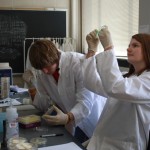
Ryan Schmidtman and Dawn Comstock working on their Myxococcus xanthus motility assays in Dr. Murphy's class.
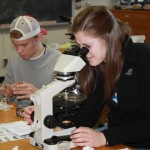
Taylor Eide and Alison Agather use a petrographic microscope to identify sand grain mineralogy from a lake sediment core in Dr. Triplett's course.
While I was in Dr. Murphy’s lab, she told me her class was going to join with Dr. Laura Triplett’s (geology) Paleolimnology course to present their final results to one another. So I dropped by the geology department and found Dr. Triplett’s students investigating the sediments in St. Peter’s own Lake Hallett. More pictures and information can be found on the Geology blog here and the Environmental Studies blog here.
From there, I followed my nose up to the third floor, where Dr. Brian O’Brien’s (chemistry) students were learning synthetic research methods by preparing molecules corresponding to interesting odors (mushroom, vanilla) and derivatives of those. There are several clips of students working in this lab course in this YouTube video about the J-term experience, including clips of students creating custom lab glassware using glassblowing techniques.
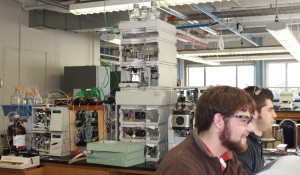
Michael Swenson ('10, left) and Tomas Liskutin ('09, right) are using the multidimensional chromatography instrument built in the Stoll laboratory (immediately behind).
A handful of students on the second floor were working on independent research projects instead of a traditional J-term course. (Is there such a thing as a “traditional J-term course”?) Students in Dr. Dwight Stoll’s (chemistry) lab were hard at work developing methods to detect small quantities of a specific molecule in a complex mixtures. In the photo, they’re working on quantifying hydrocortisone in human urine. There are a couple students working in my lab, too (also chemistry). On the day I visited with the camera, they were purifying protein samples so that we can later study how those proteins fold and bind metal atoms.
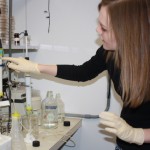
Alysha Dicke in the cold room (think walk-in refrigerator) purifying protein for her research with Dr. Russell.
And this is just a small sampling: I know I’ve just covered a handful of the students and classes that were doing research, scholarship, and creative work this J-term. For example, I didn’t get a chance to make it to visit the students working on Urinetown, which features significant creative input from students. Notably, students are given credit for set and costume design in the recent story about the production. (By the way, there are still performances of this next weekend, see that last link for ticket information!)
Tell us about your J-term student research experience in the comments!
